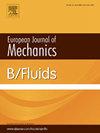三维多孔结构液槽内液体晃动的边界元分析
IF 2.5
3区 工程技术
Q2 MECHANICS
引用次数: 0
摘要
本文用边界元法研究了三维多孔容器内的液体晃动问题。基于线性势流理论和伯努利方程,给出了三维液体晃动问题的离散化策略,并详细推导了边界元积分方程。采用边界上定义的边界积分方程作为控制方程,可以将问题转化为二维框架。这些方程随后通过边界元素的插值转换为代数方程,这大大减少了所需节点的数量。根据达西定律和伯努利方程建立了多孔结构两侧的边界条件。该研究考察了立方体、圆柱形和环形圆柱形液体罐的晃动行为,并采用多孔挡板来减轻晃动现象。数值结果证明了所提模型的准确性和可靠性,表明修改多孔挡板的长度、宽度、形状和其他几何尺寸会显著影响槽内液体的晃动响应。通常,在不同形状的液罐内,横向多孔挡板的安装位置越高,对液体晃动的抑制作用越强,而垂直挡板的配置则取决于罐的具体形状。随着孔隙效应参数的增大,响应峰值呈先减小后增大的趋势。分析了线性势流理论的局限性,提出了今后的研究方向。本文章由计算机程序翻译,如有差异,请以英文原文为准。
Boundary element analysis of liquid sloshing in a three-dimensional liquid tank with porous structure
This paper investigates the liquid sloshing problem in three-dimensional tanks with a porous structure using the boundary element method (BEM). Based on linear potential flow theory and the Bernoulli equation, we present a discretization strategy along with a detailed derivation of the boundary element integral equation for the three-dimensional liquid sloshing problem. The problem can be transformed into a two-dimensional framework by employing boundary integral equations defined on the boundary as the governing equations. These equations are subsequently converted into algebraic equations through the interpolation of boundary elements, which significantly reduces the number of required nodes. The boundary conditions on both sides of the porous structure are established in accordance with Darcy's law and the Bernoulli equation. The study examines the sloshing behavior both in cubic, cylinder and annular cylinder liquid tanks, incorporating a porous baffle to mitigate the sloshing phenomenon. Numerical results demonstrate the accuracy and reliability of the proposed model, indicating that modifications to the length, width, shape, and other geometric dimensions of the porous baffle significantly influence the sloshing response of the liquid within the tank. Generally, a higher installation position of the transverse porous baffle within liquid tanks of varying shapes enhances the suppression of liquid sloshing, while the configuration of the vertical baffle is contingent upon the specific shape of the tank. Additionally, as the porous-effect parameter increases, the peak value of the responses initially decreases before subsequently increasing. In addition, the limitations of linear potential flow theory were analyzed, and future research directions were suggested.
求助全文
通过发布文献求助,成功后即可免费获取论文全文。
去求助
来源期刊
CiteScore
5.90
自引率
3.80%
发文量
127
审稿时长
58 days
期刊介绍:
The European Journal of Mechanics - B/Fluids publishes papers in all fields of fluid mechanics. Although investigations in well-established areas are within the scope of the journal, recent developments and innovative ideas are particularly welcome. Theoretical, computational and experimental papers are equally welcome. Mathematical methods, be they deterministic or stochastic, analytical or numerical, will be accepted provided they serve to clarify some identifiable problems in fluid mechanics, and provided the significance of results is explained. Similarly, experimental papers must add physical insight in to the understanding of fluid mechanics.

 求助内容:
求助内容: 应助结果提醒方式:
应助结果提醒方式:


